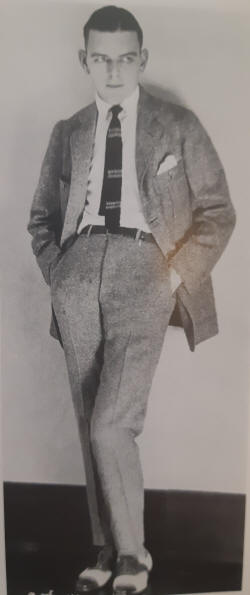

Partner Ramon Novarro
Queer Places:
Fort Rosecrans National Cemetery
San Diego, San Diego County, California, USA
 Herbert
Riley Howe (September 28, 1893 - October 19, 1959) was a popular Hollywood
news writer in the 1920s. He worked as a press agent for the director Jerome
Stern.
Herbert
Riley Howe (September 28, 1893 - October 19, 1959) was a popular Hollywood
news writer in the 1920s. He worked as a press agent for the director Jerome
Stern.
Howe was born in Sioux Falls, South Dakota on September 28, 1893, the son of Solomon B. Howe (1862–1937), a New York-born civil engineer, and Carrie Riley (1869–1949). While his father helped design the city's infrastructure, young Herb grew up in a wilderness of big country and sky, with Indians in buckskin and feathers still a common sight on downtown streets. As a teenager Herb would sit for hours in a nickelodeon operated by his uncle, mooning over such early stars as Florence Lawrence and J. Warren Kerrigan. After graduating from the State University, he found his way to New York, where he worked for various film companies as a publicist.
During WWI Howe was a Sergeant of the Tank Corps. After the was he got a job with the New York Telegraph, which in 1920 sent him to Hollywood as a correspondent. He also began writing for Picture Play magazine, a position he resigned in the spring of 1921 to become the western representative for the Brewster publications (Shadowland, Motion Picture, Motion Picture Classic). In 1922 he began his long-running engagement with Photoplay, writing the column "Close-Ups and Long Shots: Witty Comments on Screen Personalities."
Closeted in keeping with the times, Howe was a lover of Ramon Novarro, for whom he worked as a publicist/press agent, and a friend of adventure traveller and travel writer Richard Halliburton. From Novarro, Herbert Howe coaxed some telling insight. "I was a dancer before I entered pictures," Novarro revealed in April 1923. "But I didn't take the work seriously. I was afraid of being thought a sis. But I'm not now. They don't like me to say it, but I like dancing."
A familiar face at industry functions, Howe lived in the Hollywood Hills with his brother Milton. He was Florence Vidor's escort to the Hollywood Bowl; he dined often with Pola Negri and took tea with Mrs. Charles Ray.
Herbert Howe was the most famous of early Hollywood's gay journalists. He tried to come off as a cynical Eastern newspaperman, but the romantic in him was exposed by the soft brown eyes of Ramon Novarro. "A brilliance in black and white," Howe wrote of the star as they sailed together to Europe, "those eyes illuminating a face of Spanish pallor... His eyes so mesmerize a mood that you forget to listen." Howe had been sent by Photoplay to cover the story of Novarro's latest picture, The Arab (1924), to be directed by Rex Ingram on location in North Africa. He'd briefly met the star before, and hadn't thought very much of him. "I didn't know him," he'd remember. "No one does out there. He keeps as aloof as Pola Negri." But on the deck, in the moonlight, their relationship began. "Novarro seduced Herbert Howe," said Lawrence Quirk, who knew both men. "That's what I always understood, that he seduced Howe and they had quite the romance. Howe even became a Roman Catholic."
In 1927, writing the "life story" of Novarro for Motion Picture magazine, Howe would admit that "biography should be impersonal. This isn't." Howe couldn't manage objectivity when it came to Ramon: "friend and advisor, I've known Novarro for four years and I still admire him." He did not shy away from the obviously romantic description of their shipboard friendship. "I must have touched a secret spring to his confidence," he wrote, "for that evening was one of charmed revelation."
Howe died of pneumonia in Los Angeles on October 23, 1959.
My published books: